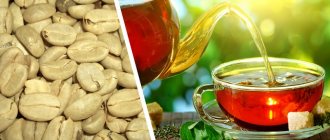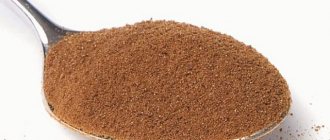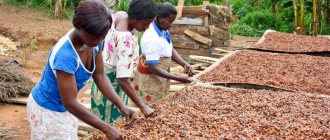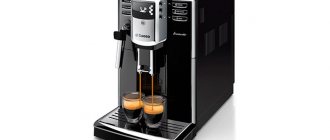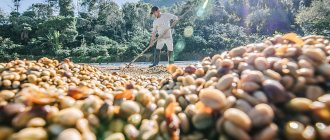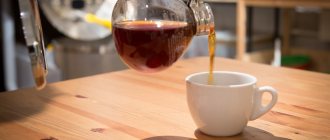Cupping is the process of professional coffee tasting. It is carried out to understand which varieties are different, what exactly the taster likes, and to try something new. During the cupping process, the shades of taste and smell of coffee are determined. There are world cupping championships; large Russian cities already host tastings in coffee shops, but you can also do cupping at home, following everything according to the rules.
Features of the capper profession
A cupper is a professional coffee taster who knows in detail the history, types of varieties, and brewing methods. He is also required to understand such complex categories as taste, smell, composition and color.
It would seem that what could be better than a job that allows you to constantly enjoy a flavorful drink and get paid for it. However, the profession has many features. The taste buds of a capper must remain sensitive, so a person of this profession should not smoke, drink alcohol, very spicy, salty, sour or sweet foods, or use perfume.
Such strict measures are justified by the working conditions: the cupper has to examine every day the barely noticeable shades of taste and smell of different types of coffee. Sometimes a professional taster can “taste” more than several hundred different varieties in a day.
Wheel of flavors
Many tasters use the flavor wheel. It is designed specifically to determine all the characteristics of coffee. For example, in some drinks you can taste the freshness of lemon, hazelnuts, herbs or even black tea. The capper usually moves from the center - simpler definitions (sweet, vegetal, baked, spicy, etc.) to more complex ones, that is, to the middle and outer circles.
So, based on the wheel of tastes, we at Sibaristica determine what to put on a pack of coffee as a description. For example, after roasting a lot of ETHIOPA GELANA SHARA with washed processing, we heard fruity notes in the taste and aroma. Having analyzed the drink even better, we found hints of juicy peach, other stone fruits and citruses in the coffee.
Why are cuppings carried out?
The main task of the process is to fully reveal the taste of coffee beans. To fully implement this idea, you need to pour boiling water over coarsely ground grains, enjoying the rich aroma, and let it brew for 4 minutes. Only after this can the tasting begin.
Cupping helps develop receptors and enrich the taste memory with different types of coffee. The ability to track complex, subtle flavors and recognize the region of origin of grains is a difficult task, but constant training can turn even a beginner into a professional.
At such tastings you can try new varieties, beans from different roasters, find or choose “your” taste, try rare unique combinations.
Where to go for cupping in Moscow
Cupping is a growing trend in the coffee industry. And if you live in Moscow, you are new to this cultural trend, and want to go to a coffee tasting, then we offer you a list of establishments where such events are systematically held:
- Cherny cooperative, Lyalin lane, building 5, building 1. Cupping is held every Sunday at 11:00. They taste their own grain and the grain of other roasters, both domestic and foreign.
- Point coffee & food, Sadovnicheskaya embankment, 75. Cupping is carried out 2 times a month.
- West 4 roasters, Olkhovskaya street, building 14, building 8, Aviator Art Space. Coffee tastings are held irregularly.
- coffee&lab, Novodmitrovskaya street, building 1, building 1. Tasting is rarely held. Large, spacious hall, specially equipped for cupping.
- Coffee shop DoubleB. Check with the barista for the cupping schedule. They drip their own roasted grain, sometimes grain from international championships or experimental samples.
Specifics of cupping
They use light or light roast coffee, but always medium grind - slightly coarser than espresso. For every 200 ml of water you will need about 11 grams of coffee.
Initially, it is poured with boiling water, stirring clockwise with a spoon, and allowed to brew until a coffee “cap” is formed.
The smell is assessed in two stages: after pouring ground beans into a glass and after “breaking” the resulting foam with a spoon.
When the smell tasting stage is completed, you can move on to the taste part. Leave the coffee for 7-10 minutes to cool slightly, then remove the remaining foam and scoop the drink into a spoon. Then it is drunk quickly with a characteristic sound, trying to distribute the liquid throughout the entire oral cavity: this way the maximum number of receptors is activated.
Criteria for evaluation
There are basic criteria that require research during the cupping process. Each of them is important both on its own and in combination with the rest of the bouquet.
- Appearance. The grains are examined visually. The drink itself is also evaluated, attention is paid to its color, foam and its shade, and other external manifestations.
- Aroma. This is one of the main characteristics of a coffee drink. The aroma can be herbal, fruity, spicy, creamy or floral. Its intensity can range from weak and barely noticeable to bright and intense. Ideally, it matches the taste characteristics, but it may happen that a drink with a bright taste will have a light and subtle aroma.
- Taste. When assessing the taste of the drink itself, 4 main parameters are examined:
- sweetness;
- bitterness;
- acidity;
- salinity.
The softness or sharpness of these characteristics and the harmony of their combination are assessed. These parameters may vary depending on the location of coffee growing, variety, and climatic conditions. Several basic combinations of flavor elements;
- harmonious (parameters are not perceptible separately);
- rich (versatile, but with a predominance of one element);
- changing (with a change in shade when cooling or with a subsequent sip);
- basic or characteristic, inherent in a particular variety.
Attention is drawn to the presence of foreign tastes and defects, for example, the presence of an earthy or moldy tint, a straw tone or a sour drink.
- Aftertaste. The feeling that appears after consumption is also important during tasting. The aftertaste can be uniform, varied, constant or changing. Possible options: chocolate, caramel, spicy, creamy. It can be unobtrusive or bright.
- Thickness, density, fullness. During the evaluation, the texture and consistency of the drink are examined separately. You should not replace these concepts with the term “strength”, as they describe the severity of the taste of coffee and its concentration.
In this regard, the oiliness, creamy consistency or wateriness of the drink, its homogeneity, viscosity, and viscousness are assessed.
The strength of coffee is not given a special role in the study, since any variety can be made softer or stronger using different preparation recipes.
Tasting rules
If a coffee lover is attending an event for the first time, he should know a few important rules:
- You need to drink water before tasting, this will help prepare the receptors.
- You should not apply strong scents to the body; this applies to both perfumes and creamy textures. Additional odors may interfere with a reliable assessment of coffee aroma.
- Gather long hair into a ponytail or bun; there should definitely be no unnecessary items in the drink.
- Check cups for dryness and cleanliness.
- It is forbidden to touch the cups after pouring boiling water - this can disrupt the brewing process, the structure of the coffee head and prevent the drink from opening.
- Don’t be shy about “serbating” – this is the name for the process in which the taster loudly inhales the drink.
- Blot and wipe the spoon after each sample - this way the taste of each new variety will not mix with the previous one.
- Do not linger long over each cup; the tasting process should happen quickly enough and as efficiently as possible. To do this, you don’t have to “hover” over a drink; it’s enough to have a piece of paper and a pen with you to write down your impressions.
- There is no need to drink coffee from a spoon, just sip the drink correctly and try to remember all the notes of taste. Professional cuppers don't drink coffee during tastings; they spit it into a trash can.
- There is no need to participate in cupping when you are sick or even have a mild cold. In a painful state, taste buds become dull, and you can also infect other participants.
What kind of “beast” is this?
Cup testing or, simply put, coffee tasting is an assessment of the aromatic and taste properties of a drink. The richness of aroma, a rich palette of flavors, the presence of invigorating sourness or warming sweetness, the level of density of the drink and its unpredictable aftertaste - all these parameters distinguish one variety from another, creating its own style and individuality. The India Monsoon Malabar coffee variety cannot be confused with anything else. Its distinctive feature is the presence of bread notes in the taste. Coffee from Costa Rica (Costa Rica Geisha Honey), on the other hand, has floral undertones.
Few people can boast of the ability to conduct high-quality coffee tasting. This is real art! Understood by trial and error, it develops in the taster a subtle sense of taste and smell. Improving your receptor skills is still half the battle. A true taster has about a thousand terms in his vocabulary that he can use to describe coffee. One spoon of coffee, and a professional in his field will tell a whole story about the drink offered to him.
Only a select few can become a privateer. Not everyone is able to deny themselves the pleasure of smoking a cigarette or sipping a glass of cognac. But this is strictly forbidden to him in order to avoid disruption of receptor sensitivity. To the forbidden list should be added foods that are too hot or, conversely, cold, as well as salty and spicy foods. However, if you gather all your will into a fist and train without putting down a cup of coffee, the result will not be long in coming.
The essence of captesting is to taste the drink and describe its aroma and taste. Each stage of this procession is important and necessary in its own way. Most people evaluate a drink based on the principle “tasty/not tasty”; in the case of a taster, each type of coffee opens up wide horizons of the unknown.
Where to begin
For all its scrupulousness, cupping is a very interesting and enjoyable pastime. As a rule, coffee tasting is carried out collectively so that tasters can discuss their impressions of the drink. A great option is to organize a mini-tasting at home, inviting friends; it will not only be educational, but also very exciting.
First, you should arm yourself with “pen and paper.” Cupping simply requires taking notes at every stage. This implies that you will describe all your sensations exactly as they presented themselves to you.
The fact is that everyone’s perception is different, especially when it comes to tastes and smells. Drawing up a detailed description of your feelings and subsequent discussion of it will help shed the truth on what the tested coffee actually tastes like.
- Adjusting the taste in a coffee machine: grinding, volume, strength from an expert
For convenience and some formalization of the tasting process, there are special forms where wine tasters enter their observations and feelings on certain parameters using a rating scale. Perhaps it would be a good idea to acquire such forms.
You should also prepare several varieties of coffee beans, which will be your “test subjects”. Ground coffee, in principle, is also suitable, but its quality, as a rule, is much lower, because in this form all the aromas quickly disappear. In this case, cupping will most likely be purely formal.
You will also need dishes - containers for brewing: cups or glasses, special spoons (but ordinary ones will do, ideally they should be small but deep), cups for draining the tested coffee, dishes for rinsing spoons. To accurately measure the amount of cupped coffee for each sample, use kitchen or special scales; whether or not to use them depends on the seriousness of your approach to tasting. Of course, you also need a coffee grinder, but as true coffee lovers you already have one. Is it true?
You might be interested in: Calorie content of instant coffee without sugar
Professional tasters
Before coffee reaches the end consumer, it is tasted many times. And every time the one who tries it will look for something new in it. While working, professional tasters make notes on special forms, which include the following parameters.
Sweetness
How much sweetness is there in coffee? This trait is highly valued, and it is believed that the more pronounced it is, the higher the quality of the coffee.
Acidity
Balance
This is the most difficult parameter to evaluate coffee. Great coffee has a variety of flavors, but do they combine harmoniously? Does it sound like a well composed tune or does one element stand out too much? Is any one aspect dominant?
Bouquet
This parameter describes not only the taste and aroma, but also how pleasant the taster finds them. For many, this is the most difficult aspect to evaluate. Each coffee they try is different, and finding words to describe the taste remains challenging.
